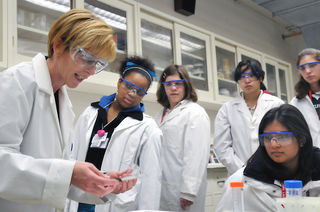Education
The Power of Stories to Teach and Motivate STEM Students
Students become more interested in STEM after learning about scientific failure.
Posted June 5, 2018
Imagine yourself in the shoes of one of these famous female scientists:
Scientist A: She attended the top college in France, the Sorbonne. Not only was she the first woman to receive a degree in physics there, she was also selected for a prestigious award when she graduated.
Scientist B: It was frustrating that many experiments ended up in failure; however, she would not let herself stay sad for too long. Instead, she returned to where things did not work out and tried again.
Scientist C: Going to college was hard for her because at that time, people did not approve of women going to school. Thus, she had to study at secret classes.
To which scientist do you most relate? Are you a trailblazer who has received myriad accolades, like Scientist A? Do you know as well as Scientist B what it’s like to fail and fail again before finding success? Have you experienced discrimination or other barriers to achieving your goals, like Scientist C? Perhaps you feel a bit of kinship with one of these influential women that piques your interest in her chosen field.
If you haven’t figured it out, these are not three famous female scientists, but one: Marie Curie. Young science students all over the world learn about her pioneering work on radioactivity and her litany of "first woman to" accomplishments, like winning the Nobel Prize. But according to research led by Dr. Xiaodong Lin-Siegler of Columbia University, how you present the story of Marie Curie and her discoveries—as well as those of other famous scientists—influences students’ interest in STEM and how well they learn scientific material.
Telling Stories to Teach STEM

Stories are a powerful way to convey information, and thus textbooks often preface scientific knowledge with the story of the people behind the discovery. But too often textbooks rely on achievement stories in which scientific breakthroughs are portrayed as the result of extraordinary people, like Marie Curie with her prestigious French education, mastery of five languages, and indefatigable resolve. What Dr. Lin-Siegler has shown is that students respond differently when a scientist is painted in more human terms, as someone who experienced both professional and personal setbacks before hitting upon the insight that made them famous.
Initially, Dr. Lin-Siegler and her colleague Huang-Yao Hong of National Chengchi University in Taipei studied how 271 Taiwanese 10th graders reacted to differing stories of famous scientists. Students were randomly assigned to complete a computer-based physics lesson that either included or omitted background information on Galileo, Sir Isaac Newton, and Albert Einstein. Moreover, stories about these scientists highlighted either their achievements or their struggles. Whereas achievement stories had no discernible effects, reading about challenges gave students a more positive image of scientists than students who had no background information provided, and increased interest in physics among those students who were initially uninterested. Additionally, students who read about scientists’ failures remembered more physics facts one week later than students who didn’t read either story, and they performed better than all other students on a test of complex problem solving.
Dr. Lin-Siegler and her colleagues replicated this work among 402 students in an urban U.S. high school where the majority came from low-income families of either African American or Hispanic background. Students read brief biographies of Einstein, Marie Curie, and Michael Faraday, framed as an achievement story (e.g., Marie Curie attending the Sorbonne), a story where they struggled in their work (e.g., Marie Curie’s failed experiments), or a story where they struggled in their personal lives (e.g., Marie Curie facing sexism). Over the next 6 weeks, students who read achievement stories showed a significant decrease in their science grades, whereas the other students' performance remained steady or improved. The benefits of scientists' stories of adversity were particularly pronounced among students who were struggling in science before the intervention took place, demonstrating this approach’s promise for helping those students most likely to drift away from STEM.
Why do Stories Affect Students’ STEM performance?
In their U.S. study, Dr. Lin-Siegler and colleagues identified a potential mechanism to explain these effects: students who read challenge stories felt more connected to scientists than those students who read about their achievements. This identification could help STEM students see scientists as role models, which can be an important building block for a student’s STEM identity. An important avenue for future research is to explore whether this identification is strengthened when students read about scientists like them, whether that means the same gender, race, ethnicity, religion, or some other defining characteristic.
Another hypothesized mechanism is that stories break down the myth that scientists are “geniuses.” Many students believe that geniuses don’t have to work hard to succeed at science and, therefore, interpret their own challenges as proof of their own lack of genius. This is a classic fixed mindset that discourages students from persevering in STEM because they believe that only geniuses can ultimately become scientists. In the U.S. study, the challenge stories failed to move the needle on students’ beliefs about intelligence, effort, and failure, but the growth mindset explanation is still a compelling one that requires further research. Dispelling the idea that people like Albert Einstein and Marie Curie were just naturally gifted in science could help students adopt a growth mindset for STEM and keep them motivated when they’re struggling to learn.
Incorporating Stories into STEM Education
As someone personally involved in designing interventions to support college students, leveraging scientists’ stories of struggle offers promise for keeping students in the STEM pipeline. First, these stories portray scientists as normal people and provide ways for students to relate to these often-mythologized figures, thus laying the foundation for students’ own identity as a scientist to develop. These stories are also likely to foster a growth mindset by articulating real-life examples of people finding success through perseverance following repeated setbacks. It is important, however, to share more than just stories of struggle: students need to understand why and how each scientist persevered. Highlighting reasons why a scientist remains motivated in the face of failure and strategies for dealing with those obstacles are key.
Finally, these studies focused on the types of stories about famous scientists often featured in textbooks. But as a motivational tool, it may be just as effective to share stories of scientists to whom students might more easily relate: their own professors. For many students, learning what led the person standing in front of the classroom to become a scientist and educator could inspire them to choose a STEM pathway better than any person long-passed, no matter how famous.
References
Ahn, J. N., Luna-Lucero, M., Lamnina, M., Nightingale, M., Novak, D., & Lin-Siegler, X. (2016). Motivating students’ STEM learning using biographical information. International Journal of Designs for Learning, 7(1), 71-85.
Hong, H.-Y., & Lin-Siegler, X. (2012). How learning about scientists’ struggles influences students’ interest and learning in physics. Journal of Educational Psychology, 104(2), 469-484.
Lin-Siegler, X., Ahn, J. N., Chen, J., Fang, F.-F. A., & Luna-Lucero, M. (2016). Even Einstein struggled: Effects of learning about great scientists’ struggles on high school students’ motivation to learn science. Journal of Educational Psychology, 108(3), 314-328.




